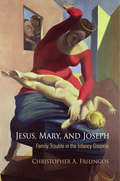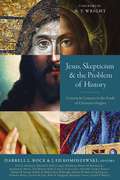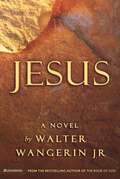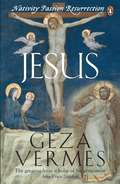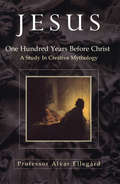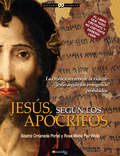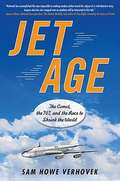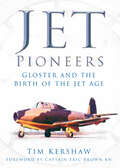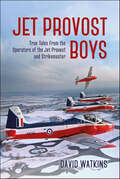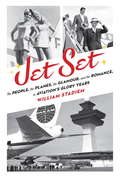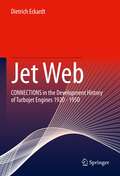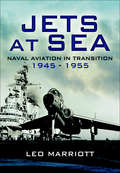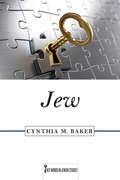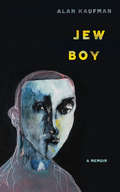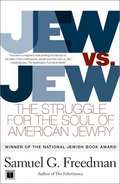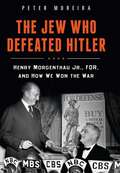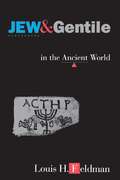- Table View
- List View
Jesus, Mary, and Joseph: Family Trouble in the Infancy Gospels
by Christopher A. FrilingosWhen Jesus was five he killed a boy, or so reports the Infancy Gospel of Thomas. A little boy had run into Jesus by accident, bumping him on the shoulder, and Jesus took offense: "Jesus was angry and said to him, 'You shall go no further on your way,' and instantly the boy fell down and died." A second story recounts how Jesus transformed mud into living birds, while yet another has Joseph telling Mary to keep Jesus in the house so that no one else gets hurt. What was life really like in the household of Joseph, Mary, and little Jesus? The canon of the New Testament provides few details, but ancient Christians, wanting to know more, would turn to the texts we know as the "Infancy Gospels."The Infancy Gospel of Thomas is a collection of stories from the mid-second century C.E. describing events in the life of Jesus between the ages of five and twelve. The Proto-gospel of James, also dating from the second century, focuses on Mary and likewise includes episodes from her childhood. These gospels are often cast aside as marginal character sketches, designed to assure the faithful that signs of divine grace cropped up in the early years of both Mary and Jesus. Christopher A. Frilingos contends instead that the accounts are best viewed as meditations on family. Both gospels offer rich portrayals of household relationships at a time when ancient Christians were locked in a fierce debate about family—not only on the question of what a Christian family ought to look like but also on whether Christians should pursue family life at all.Describing the conflicts of family life, the gospels present Jesus, Mary, and Joseph in moments of weakness and strength, reminding early Christians of the canyon separating human ignorance and divine knowledge. According to Frilingos, the depicted acts of love and courage performed in the face of great uncertainty taught early Christian readers the worth of human relationships.
Jesus, Skepticism, and the Problem of History: Criteria and Context in the Study of Christian Origins
by ZondervanIn recent years, a number of New Testament scholars engaged in academic historical Jesus studies have concluded that such scholarship cannot yield secure and illuminating conclusions about its subject, arguing that the search for a historically "authentic" Jesus has run aground.Jesus, Skepticism, and the Problem of History brings together a stellar lineup of New Testament scholars who contend that historical Jesus scholarship is far from dead.These scholars all find value in using the tools of contemporary historical methods in the study of Jesus and Christian origins. While the skeptical use of criteria to fashion a Jesus contrary to the one portrayed in the Gospels is methodologically unsound and theologically unacceptable, these criteria, properly formulated and applied, yield positive results that support the Gospel accounts and the historical narrative in Acts. This book presents a nuanced and vitally needed alternative to the skeptical extremes of revisionist Jesus scholarship that, on the one hand, uses historical methods to call into question the Jesus of the Gospels and, on the other, denies the possibility of using historical methods to learn about Jesus.
Jesus: A Beginner's Guide (Beginner's Guides)
by Anthony Le DonneJesus: A Beginner&’s Guide introduces Jesus, the man and his enduring legacy. Separating fact from fiction, Professor Le Donne places Jesus within the context of first-century Judaism, and explores the debate about his status as 'Son of God' among the early Christians. He then follows his legacy through medieval Europe, and compares the various cultural Jesuses in enlightenment and post-enlightenment thought.
Jesus: A Historical Portrait
by Daniel Harrington<p>Was Jesus a feminist? Who really killed Jesus? Did all those miracles actually happen? How do we know who Jesus is? How are we supposed to know what Jesus really said? How does Jesus' Judaism fit in with our salvation as Christians? <p>Questions about the life and times of Jesus Christ, one of the most written-about people of all time, continue to intrigue us two millennia after his death. Between the vagueness of the canonical Gospels and the sensational claims made in modern films and books, what is a Christian to believe about the only Son of God? <p>Employing a popular take on current New Testament scholarship, Jesuit scholar Father Daniel Harrington explores difficult as well as less complicated issues surrounding the life of Christ. By helping us to place Jesus in a historically accurate context, Father Harrington helps us to better understand the real Jesus, and ultimately, our salvation. <p>Fascinating sidebars and engaging questions for reflection and discussion make Jesus: A Historical Portrait a must-have book for the individual, small group or classroom.</p>
Jesus: A Novel
by Walter Wangerin Jr.Walter Wangerin Jr. is know for his powerful storytelling in such books as The Book of the Dun Cow, The Book of God, and Paul: A Novel. Now he offers the most important story of the Christian faith—the life of Jesus presented in the author’s inimitable style. Rich in atmosphere and historical detail and as compelling as any contemporary fiction, this novel will move readers with its creative perspectives and deep insights.
Jesus: A Prophet of Islam
by Muhammad Ata' ur-RahimA history and synopsis of the life of the prophet Jesus in the Moslim books Quran and Hadith. The first part tells us the history and time Jesus was born into, that we know and don't know from the Bible, the second part tells us about some parts of the apocrypha left out of the Bible in 326 A.D. and Nicea, and the 3rd part tells us about the Hadith and Quran where we learn about the prophet Jesus and how the Moslims know him.
Jesus: Nativity - Passion - Resurrection (Scm Classics Ser.)
by Dr Geza VermesThe Nativity, Passion and Resurrection are the three defining episodes in the life of Jesus, forming the foundations of the Christian tradition. But what is the truth behind these epoch-making events?Geza Vermes is one of the world's most respected bibilical historians. Bringing together his three acclaimed works on the life of Jesus in one volume, this book examines the circumstances surrounding the miraculous birth of Jesus, from the prophetic star to Herod's murderous decree; looks afresh at the arrest, trial and execution of this Jewish charismatic; and finally analyses Jesus' crucifixion and the subsequent sightings of him by his disciples. Drawing on the New Testament, Jewish documents and sources from classical literature and history, these works separate myth from fact to penetrate the deeper meanings of the story of Christ.
Jesus: One Hundred Years Before Christ - A Study In Creative Mythology
by Alvar EllegardThe starting point for the book is the following anomoly: If Jesus lived as has been supposed at the beginning of the 1st century AD, the only NT documents written by a near contemporary, the Epistles of St Paul, make no mention of him as an historical figure, neither do they record any of his sayings, but rather they talk of him as a vision or mystical experience of the risen Christ. Further, the same is true of the earliest Christian non-NT texts, such as the Epistles of St Clement, roughly contemporary with Paul. Furthermore, contemporary records of the region from non-Christian sources, such as those by the Jewish historian Josephus, fail to mention Jesus at all where we would expect them to; the mentions that there are have recently been shown to be later interpolations by medieval Christian apologists - the gospel accounts of Jesus and his millieu are inaccurate in all major respects e. g. the relative dates of Herod and Pilate, if contemporary Roman and Jewish historians, who had no theological axe to grind, are taken as measure. By comparative textual studies, the author shows that the gospel accounts of Jesus' life and sayings were written approximately 100 years after Jesus is supposed to have lived, and so 100 years later than alleged contemporaries such as Paul, Clement, Josephus etc.
Jesús según los Apócrifos (Historia Incógnita)
by Beatriz OntanedaPor respeto a la historia, Jesús según los apócrifos es un libro que no sigue la línea oficial de la Iglesia. Se sabrá acerca de la inseminación artificial a la que se sometió María y que su famosa virginidad se debía a una terapia esenia que se mantuvo en secreto durante siglos. Se conocerá la infancia conflictiva de Jesús, su mal carácter y los asesinatos involuntarios que cometió.
Jesús. la historia alternativa
by Carlos Uribe CelisCon un enfoque crítico-histórico, este libro presenta una historia material y realista de la vida, pasión y muerte de Jesús. La tradición historiográfica conocida como La búsqueda de Jesús ha estado vigente al menos en los últimos tres siglos. Sus fuentes son principalmente la crítica textual: qué dicen y qué omiten los evangelios canónicos; la crítica histórica, es decir qué registraron sobre Jesús los historiadores, políticos y militares de su época; y la arqueología, que permite comprender los contextos y comportamientos en el tiempo en que vivió Jesús y apareció el cristianismo. Sobre esta base, este libro toma partido por varias de estas tesis y hace algunos aportes sobre el estudio del Jesús histórico, muchos de ellos desconocidos para el público general como, por ejemplo, que la familia de Jesús en galilea es adoptiva, que Jesús se entrega él mismo a la autoridad judía y Judas es su agente, y que Jesús no muere en la cruz sino en India.
Jet Age
by Sam Howe VerhovekThe captivating story of the titans, engineers, and pilots who raced to design a safe and lucrative passenger jet. In Jet Age, journalist Sam Howe Verhovek explores the advent of the first generation of jet airliners and the people who designed, built, and flew them. The path to jet travel was triumphal and amazingly rapid-less than fifty years after the Wright Brothers' first flight at Kitty Hawk, Great Britain led the world with the first commercial jet plane service. Yet the pioneering British Comet was cursed with a tragic, mysterious flaw, and an upstart Seattle company put a new competitor in the sky: the Boeing 707 Jet Stratoliner. Jet Age vividly recreates the race between two nations, two global airlines, and two rival teams of brilliant engineers for bragging rights to the first jet service across the Atlantic Ocean in 1958. At the center of this story are great minds and courageous souls, including Sir Geoffrey de Havilland, who spearheaded the development of the Comet, even as two of his sons lost their lives flying earlier models of his aircraft; Sir Arnold Hall, the brilliant British aerodynamicist tasked with uncovering the Comet's fatal flaw; Bill Allen, Boeing's deceptively mild-mannered president; and Alvin "Tex" Johnston, Boeing's swashbuckling but supremely skilled test pilot. The extraordinary airplanes themselves emerge as characters in the drama. As the Comet and the Boeing 707 go head-to-head, flying twice as fast and high as the propeller planes that preceded them, the book captures the electrifying spirit of an era: the Jet Age. In the spirit of Stephen Ambrose's Nothing Like It in the World, Verhovek's Jet Age offers a gorgeous rendering of an exciting age and fascinating technology that permanently changed our conception of distance and time, of a triumph of engineering and design, and of a company that took a huge gamble and won.
Jet Age: The Comet, the 707, and the Race to Shrink the World
by Sam Howe VerhovekThe book is the captivating story of the titans, engineers, and pilots who raced to design a safe and lucrative passenger jet.
Jet Combat in the Nuclear Age: Jet Fighter Campaigns?1980s to the Present Day
by Martin W. BowmanFollow the fighters of the strategic nuclear strike force.In this book, the roles of jet fighters and fighter bombers in the Nuclear Age are explored. Bowman consolidates a range of firsthand accounts from the pilots themselves with a well-researched history of military aviation from the 1980s to today.Jet Combat in the Nuclear Age pays tribute to the men and women of the USAF Strategic Air Command (SAC) and their role in maintaining peace by deterring any perceived Soviet threat with a retaliatory nuclear attack. The 1980s also brought a new enemy in air operations in the Middle East when US Navy F-14 Tomcats and other jet aircraft mounted retaliatory operations against Libya.The book spotlights military craft in action across the globe: US Navy A-6E Intruders bombed Benghazi in 1986 in retaliation for the bombing of a West Berlin disco F-111Fs and RAF Jaguars decimated Saddam Hussein’s forces in the opening rounds of Desert Storm Carrier-based craft deployed in support of military operations Joint Endeavor, Desert Strike, and Sharp GuardToday the war against terror continues to rely on air power, with small teams of Special Forces troops directing attack aircraft against enemy positions. Jet Combat in the Nuclear Age outlines an era when victory comes from above.Skyhorse Publishing, as well as our Arcade imprint, are proud to publish a broad range of books for readers interested in history--books about World War II, the Third Reich, Hitler and his henchmen, the JFK assassination, conspiracies, the American Civil War, the American Revolution, gladiators, Vikings, ancient Rome, medieval times, the old West, and much more. While not every title we publish becomes a New York Times bestseller or a national bestseller, we are committed to books on subjects that are sometimes overlooked and to authors whose work might not otherwise find a home.
Jet Pioneers
by Tim KershawIn April 1941 Britain's first jet left the ground at a grass airfield 4 miles from Gloucester Cathedral. It was the start of a revolution in air travel, military and civilian. During the 1940s Britain's first-ever jet aircraft, the world's first jet fighter in squadron service and the first jet to hold the world air-speed record were all designed, built and flown in the Gloucester and Cheltenham area. The story of Frank Whittle's invention and dogged development of the jet engine is well known. But the account of how his invention was put into the air has never been fully told. This book tells the story of how the men and women of north Gloucestershire made Whittle's engine fly.
Jet Provost Boys: True Tales from the Operators of the Jet Provost and Strikemaster
by David WatkinsAs a versatile and undemanding aircraft, the Jet Provost established itself as the basic trainer for the RAF from the late 1950s until its retirement in September 1993. In Jet Provost Boys, David Watkins explores the history of this magnificent flying machine through the vivid memories of former air crew from the RAF and foreign air forces. Alongside operating as a basic training aircraft, the Jet Provost had relative success within the civilian and military display flying circuit of the 1960s and 1970s. It was also part of the prestige Golden Eagle Flight at RAF Cranwell which taught the then-Prince of Wales how to fly. When the Jet Provost Mk. 5 model became the BAC 167 Strikemaster after some modifications, it became a counter-insurgency and light-attack aircraft. This capability allowed the aircraft to be sold to air forces around the world including Ceylon, Nigeria, New Zealand, Sudan and Venezuela where it played a reliable and effective role in multiple border disputes and internal warfare. It was crucial to the Sultan of Oman Air Force during the Dhofar War as the intervention of Strikemasters assisted in a significant turning point in the conflict. This book includes a foreword by Squadron Leader Terry Lloyd who was the leader of the 1964–1965 Pelicans display team as well as being illustrated throughout with black and white and color photos. This latest addition to the Boys series is not to be missed and will appeal to all aviation fans.
Jet Set
by William StadiemIn October 1958, Pan American World Airways began making regularly scheduled flights between New York and Paris, courtesy of its newly minted wonder jet, the Boeing 707. Almost overnight, the moneyed celebrities of the era made Europe their playground. At the same time, the dream of international travel came true for thousands of ordinary Americans who longed to emulate the "jet set" lifestyle. Bestselling author and Vanity Fair contributor William Stadiem brings that Jet Age dream to life again in the first-ever book about the glamorous decade when Americans took to the skies in massive numbers as never before, with the rich and famous elbowing their way to the front of the line. Dishy anecdotes and finely rendered character sketches re-create the world of luxurious airplanes, exclusive destinations, and beautiful, wealthy trendsetters who turned transatlantic travel into an inalienable right. It was the age of Camelot and "Come Fly with Me," Grace Kelly at the Prince's Palace in Monaco, and Mary Quant miniskirts on the streets of Swinging London. Men still wore hats, stewardesses showed plenty of leg, and the beach at Saint-Tropez was just a seven-hour flight away. Jet Set reads like a who's who of the fabulous and well connected, from the swashbuckling "skycoons" who launched the jet fleet to the playboys, moguls, and financiers who kept it flying. Among the bold-face names on the passenger manifest: Juan Trippe, the Yale-educated WASP with the Spanish-sounding name who parlayed his fraternity contacts into a tiny airmail route that became the world's largest airline, Pan Am; couturier to the stars Oleg Cassini, the Kennedy administration's "Secretary of Style," and his social climbing brother Igor, who became the most powerful gossip columnist in America--then lost it all in one of the juiciest scandals of the century; Temple Fielding, the high-rolling high priest of travel guides, and his budget-conscious rival Arthur Frommer; Conrad Hilton, the New Mexico cowboy who built the most powerful luxury hotel chain on earth; and Mary Wells Lawrence, the queen bee of Madison Avenue whose suggestive ads for Braniff and other airlines brought sex appeal to the skies. Like a superfueled episode of Mad Men, Jet Set evokes a time long gone but still vibrant in American memory. This is a rollicking, sexy romp through the ring-a-ding glory years of air travel, when escape was the ultimate aphrodisiac and the smiles were as wide as the aisles. Praise for Jet Set "Aeronautics history, high times from the 1950s and '60s, incredibly versatile name-dropping (from Mrs. John Jacob Astor to Christine Keeler of the Profumo scandal) and Sinatra's 'Come Fly With Me' as a kind of theme song [all] connected to the glamorous days of air travel."--Janet Maslin, The New York Times "What a book William Stadium has written. . . . The Kennedys, the Rat Pack, Frank Sinatra, and early financiers like Eddie Gilbert are dealt with in depth. . . . I lived intimately through it all in the '50s, '60s, '70s, '80s, and '90s and I am yet to find a mistake in author Stadiem's amazing book. Order it now. All the players are here."--Liz Smith, syndicated columnist "William Stadiem sexes up the glory days of aviation in Jet Set. Fly me!"--Vanity Fair "William Stadiem's Jet Set takes you where no modern airliner can: to a time . . . when the means of travel was as exotic as the destination, and sometimes more so."--Town & CountryFrom the Hardcover edition.
Jet Wars in the Nuclear Age: 1972 to the Present Day
by Martin W. BowmanThis book explores the era of the 1970s right up to the present day, illustrating howfighter-bombers and tactics have developed and evolved during this time. It covers all the most significant military conflicts that have characterised this era, including the Eleven Day War of Christmas 1972 in Vietnam and the Falklands War of 1982, when Harrier pilots engaged in aerial battles with Skyhawks and when Vulcans, supported by Victor tankers, flew 'Black Buck' raids on Argentine positions. It also explores the era of the Gulf War, which witnessed the Victor and the B-52 fighting alongside Buccaneers, Tornadoes and F-111s.Then there is the ongoing war against terror, culminating in the opening stages of 'Inherent Resolve' which has seen Tornadoes, F/A-18 Hornets, Soviet-built Su-24M2 and Su-30CM jet fighters, Su-25 SM armoured subsonic close air support/attack aircraft, Su-34 multi-role fighter/bombers and the Tupolev Tu-160 'Blackjack' heavy strategic bombers employed in the war against Islamic State in Iraq and Syria.The author's well-researched historical narrative sets a range of dramatic first-hand crew-member accounts solidly in context, creating a rounded and authentic sense of events as they played out during five dynamic decades of aviation history.
Jet Web: CONNECTIONS in the Development History of Turbojet Engines 1920 - 1950
by Dietrich EckardtThe present book describes the development history of turbojet engines, mainly in the web-type triangle Great Britain (USA) - Germany - Switzerland from early beginnings in the 1920s up to the first practical usage in the 1950s, before the still unbroken, grand impact of aero propulsion technology on global air traffic started. interconnections are highlighted, including the considerable impact of axial-flow compressor design know-how of the Swiss/German company BBC Brown Boveri & Cie. on both sides.The author reveals significant undercurrents which led to a considerable exchange, and thus change in understanding of the technical-historical perspective, especially in the decisive years before WWII, and thus closes gaps in the unilateral views of this ground-breaking technical advancement. The old ‘Whittle vs. von Ohain Saga’ is not repeated in full, but addressed in sufficient detail to understand the considerably enlarged narrative scope.
Jet Web: Zur Entwicklungsgeschichte der Turbojet-Triebwerke 1920-1950
by Dietrich EckardtDas vorliegende Buch beschreibt die Entwicklungsgeschichte der Turbo-Luftstrahltriebwerke, hauptsächlich im Beziehungsdreieck Großbritannien (USA) – Deutschland – Schweiz von frühen Anfängen in den 1920er Jahren bis zu ersten zivilen Anwendungen in den späten 1950er Jahren, ehe der bis heute anhaltende Siegeszug des Welt-Luftverkehrs begann. Unerwartete Verbindungen werden hervorgehoben, insbesondere der beträchtliche Einfluss der Axialverdichter-Technologie des schweizerisch-deutschen Unternehmens BBC Brown Boveri & Cie. auf die beiden anderen Seiten.Der Autor deckt wichtige Beziehungen und Abhängigkeiten auf, die einen erheb-lichen technischen Austausch förderten, und daher zu einer Änderung der bisherigen technisch-historischen Betrachtungsweise führen müssen, insbesondere in den entscheidenden Jahren vor Beginn des Zweiten Weltkriegs. Damit werden bestehende Lücken in der bisher allzu einseitigen Sicht auf diesen technisch herausragenden Entwicklungsfortschritt geschlossen. Die überlieferte ‚Whittle vs. von Ohain Saga‘ wird nicht in Gänze wiederholt, aber insoweit angesprochen, wie es zum Verständnis des nunmehr erheblich erweiterten Geschichtsbilds erforderlich ist.
Jets at Sea: Naval Aviation in Transition, 1945–55
by Leo MarriottAs World War Two drew to a close, jet-powered aircraft were beginning to be introduced into service. To take advantage of this major development it was necessary for all the worlds air powers to rethink combat tactics and develop the means of handling these faster and generally larger aircraft in the air, on land and especially at sea. As this modern breed approached and finally broke the sound barrier, so did landing and takeoff speeds. The decade after the war saw rapid developments in the design of both naval aircraft and their seaborne bases the aircraft carrier. The first jet to land aboard a carrier was a modified de Havilland Vampire in 1945 on H.M.S. Ocean. Progress was rapid and the application of British inventions such as the angled flight-deck, steam catapult and mirror landing sight soon became adopted by the major navies of the world. Naval aircraft too became more sophisticated by the addition of high-lift flap systems and strengthened undercarriages to allow them to operate more safely at sea. The author describes the development of these improvements and then their operational advantages in the Korean War and Suez. He goes on to describe the US development of a potential nuclear carrier-borne bomber, the French Navy and its withdrawal from Vietnam in 1954 and then the use of naval aircraft for anti-submarine work.
Jew
by Cynthia M. BakerJew. The word possesses an uncanny power to provoke and unsettle. For millennia, Jew has signified the consummate Other, a persistent fly in the ointment of Western civilization’s grand narratives and cultural projects. Only very recently, however, has Jew been reclaimed as a term of self-identification and pride. With these insights as a point of departure, this book offers a wide-ranging exploration of the key word Jew—a term that lies not only at the heart of Jewish experience, but indeed at the core of Western civilization. Examining scholarly debates about the origins and early meanings of Jew, Cynthia M. Baker interrogates categories like “ethnicity,” “race,” and “religion” that inevitably feature in attempts to define the word. Tracing the term’s evolution, she also illuminates its many contradictions, revealing how Jew has served as a marker of materialism and intellectualism, socialism and capitalism, worldly cosmopolitanism and clannish parochialism, chosen status, and accursed stigma. Baker proceeds to explore the complex challenges that attend the modern appropriation of Jew as a term of self-identification, with forays into Yiddish language and culture, as well as meditations on Jew-as-identity by contemporary public intellectuals. Finally, by tracing the phrase new Jews through a range of contexts—including the early Zionist movement, current debates about Muslim immigration to Europe, and recent sociological studies in the United States—the book provides a glimpse of what the word Jew is coming to mean in an era of Internet cultures, genetic sequencing, precarious nationalisms, and proliferating identities.
Jew Boy: A Memoir
by Alan KaufmanJew Boy is Alan Kaufman's riveting memoir of being raised by a Jewish mother who survived the Holocaust. This pioneering masterpiece, the very first memoir of its kind by a member of the Second Generation is Kaufman's coming-of-age account, by turns hilarious and terrifying, written with irreverent humor and poetic introspection. Throughout the course of his memoir, Kaufman touches on the pain, guilt, and confusion that shape the lives and characters of American-born children of Holocaust survivors. Kaufman struggles to comprehend what it means to be Jewish as he deals with the demons haunting his mother and attempts to escape his wretched home life by devoting himself to high school football. He eventually hitchhikes across the country, coming face-to-face with the phantoms he fled. Taking us from the streets of the Bronx to the highways of America, the kibbutzim and Israeli army to personal rebirth in San Francisco, and finally to a final reckoning in Germany, Jew Boy shines with the universal humanity of a brilliant writer embracing the gift of life. Kaufman's fierce passion will leave no reader untouched.
Jew Vs. Jew: The Struggle for the Soul of American Jewry
by Samuel G. FreedmanAt a time when American Jews should feel more secure and cohesive than ever, civil war is tearing apart their community. Congregations, neighborhoods, even families are taking sides in battles about Jewish identity and Jewish authenticity.
Jew Who Defeated Hitler: Henry Morgenthau Jr., FDR, and How We Won The War
by Peter MoreiraPresident Franklin D. Roosevelt coined the slogan "The Arsenal of Democracy" to describe American might during the grim years of World War II. The man who financed that arsenal was his Secretary of the Treasury, Henry Morgenthau Jr. This is the first book to focus on the wartime achievements of this unlikely hero-a dyslexic college dropout who turned himself into a forceful and efficient administrator and then exceeded even Roosevelt in his determination to defeat the Nazis. Based on extensive research at the FDR Library in Hyde Park, NY, author Peter Moreira describes Morgenthau's truly breathtaking accomplishments: He led the greatest financial program the world has ever seen, raising $310 billion (over $4.8 trillion in today's dollars) to finance the war effort. This was largely done without the help of Wall Street by appealing to the patriotism of the average citizen through the sale of war bonds. In addition, he championed aid to Britain before America entered the war; initiated and oversaw the War Refugee Board, spearheading the rescue of 200,000 Jews from the Nazis; and became the architect of the 1944 Bretton Woods Conference, which produced the modern economic paradigm. The book also chronicles Morgenthau's many challenges, ranging from anti-Semitism to the postwar "Morgenthau Plan" that was his undoing. This is a captivating story about an understated and often overlooked member of the Roosevelt cabinet who played a pivotal role in the American war effort to defeat the Nazis.
Jew and Gentile in the Ancient World: Attitudes and Interactions from Alexander to Justinian
by Louis H. FeldmanRelations between Jews and non-Jews in the Hellenistic-Roman period were marked by suspicion and hate, maintain most studies of that topic. But if such conjectures are true, asks Louis Feldman, how did Jews succeed in winning so many adherents, whether full-fledged proselytes or "sympathizers" who adopted one or more Jewish practices? Systematically evaluating attitudes toward Jews from the time of Alexander the Great to the fifth century A.D., Feldman finds that Judaism elicited strongly positive and not merely unfavorable responses from the non-Jewish population. Jews were a vigorous presence in the ancient world, and Judaism was strengthened substantially by the development of the Talmud. Although Jews in the Diaspora were deeply Hellenized, those who remained in Israel were able to resist the cultural inroads of Hellenism and even to initiate intellectual counterattacks. Feldman draws on a wide variety of material, from Philo, Josephus, and other Graeco-Jewish writers through the Apocrypha, the Pseudepigrapha, the Church Councils, Church Fathers, and imperial decrees to Talmudic and Midrashic writings and inscriptions and papyri. What emerges is a rich description of a long era to which conceptions of Jewish history as uninterrupted weakness and suffering do not apply.
